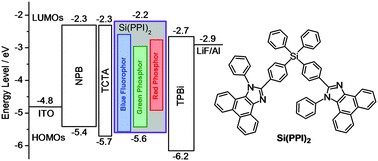A novel tetraphenylsilane–phenanthroimidazole hybrid host material for highly efficient blue fluorescent, green and red phosphorescent OLEDs†
Abstract
A novel organosilane compound, bis(4-(1-phenylphenanthro[9,10-d]imidazol-2-yl)phenyl)diphenylsilane (Si(PPI)2), has been designed and synthesized. It has a high thermal decomposition temperature of 528 °C and is able to form an amorphous glass with a high glass-transition temperature of 178 °C. In addition, it possesses high singlet and triplet energies and displays efficient energy transfer to the selected blue fluorescent and green and red phosphorescent dopants when used as a host material. Electrochemical measurements and single-carrier devices indicate that Si(PPI)2 is a bipolar transport material, allowing the injection and transport of both electrons and holes. By using (Si(PPI)2) as a host, high-performance fluorescent blue (FB) and phosphorescent green (PG) and red (PR) OLEDs with a uniform and simple device configuration have been achieved. These OLEDs exhibit very high peak external quantum efficiency (EQE) and peak power efficiency (PE), i.e. 6.1% and 8.0 lm W−1 for FB, 19.2% and 51.1 lm W−1 for PG and 12.0% and 15.6 lm W−1 for PR. Moreover, the high-level EQE of 4.0, 19.1 and 10.6% and PE of 3.0, 41.6 and 7.5 lm W−1 can be maintained by FB, PG and PR, respectively, at the practical luminance of 100 cd m−2. Furthermore, the emission colors of these OLEDs remain almost unchanged within the whole range of driving voltages. Importantly, the blue OLED displays a pure blue emission (CIE: 0.18, 0.17).


 Please wait while we load your content...
Please wait while we load your content...